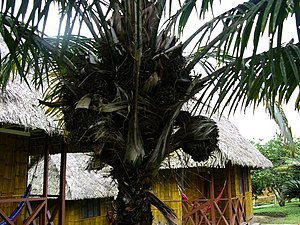Phytelepheae
| Phytelepheae | ||||||||||||
|---|---|---|---|---|---|---|---|---|---|---|---|---|

Phytelephas sp. |
||||||||||||
| Systematics | ||||||||||||
|
||||||||||||
| Scientific name | ||||||||||||
| Phytelepheae | ||||||||||||
| Horan. |
The Phytelepheae are a tribe of the palm family (Arecaceae). All representatives supply vegetable ivory , which is obtained from the hard endosperm .
features
Characteristic features of the representatives, which distinguish them from those of other branches, are the diocyte and the strongly dimorphic flowers .
The palms are medium to very large, without a trunk or with an upright trunk and are always unarmed. They are diocesan and bloom several times. The leaves are pinnate and the segments are reduplicated folded (Λ-shaped). Male and female inflorescences are significantly different. The cover sheet is rather short and mostly covered by the leaf sheath. There is a bract on the peduncle. The male inflorescences are spike or grape-shaped , the female are head-like.
The flowers are multi-part. The male flowers have small perianth lobes and the stamens are numerous. The female flowers have numerous large perianth segments. The gynoeceum consists of four to ten carpels , each containing an ovule . The fruit has a corky warty pericarp , the number of seeds corresponds to that of the ovules. The fruits stand in a head-like, crowded fruit cluster. The mesocarp ruptures and forms irregular, fibrous, pyramidal warts. The stone cores are smooth, hard, thin and enclose the seeds. The endosperm is very hard and homogeneous.
distribution
The representatives of the Phytelepheae are native to northern South America.
Systematics
The Phytelepheae are assigned to the subfamily Ceroxyloideae within the Arecaceae family . The tribes as defined by Dransfield et al. (2008) is a natural kin group ( Monophylum ). Her sister group are the Ceroxyleae .
The tribe consists of three closely related genera, which differ in the structure of the male flowers:
supporting documents
- John Dransfield, Natalie W. Uhl, Conny B. Asmussen, William J. Baker, Madeline M. Harley, Carl E. Lewis: Genera Palmarum. The Evolution and Classification of Palms . 2nd edition, Royal Botanic Gardens, Kew 2008, ISBN 978-1-84246-182-2 , pp. 333, 345f.